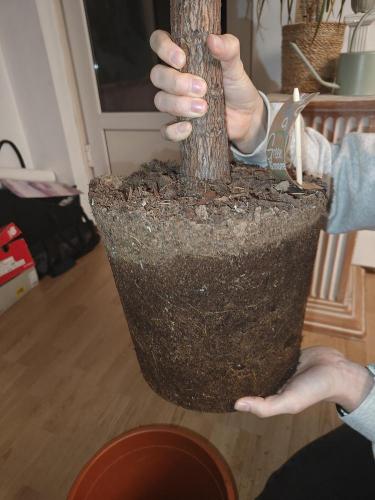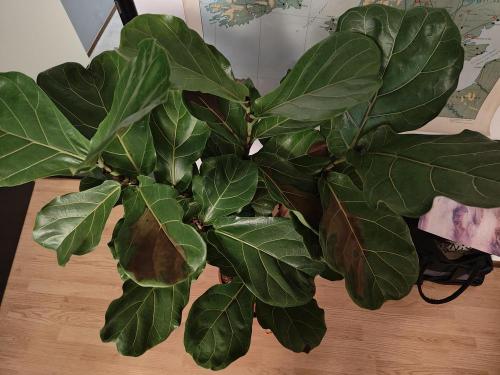We have had the plant for about 1,5 months. After about a month we noticed some of the leafs slowly turning brown. Within the first month the plant was not moved and got regular water from us. We however do suspect now that we didn't give the plant time to fully dry in between waterings as the roots were very moist when we looked at them a few days ago ... If the plant was sold soon after it left the nursery where it was grown, the 1.5 month interval would be about right when it comes to timing of shedding after a significant decrease in light levels.
After we noticed the brown spots we moved it to a lighter location, a few metres closer to our window. The process, however, continued. Light diminishes inversely by the square of the distance your plant is from the light's source. Using your plant as an example, if it was located 5m from the window and you moved it to 1 meter from the window, that would mean plant (or at least the side of the plant closest to the window) would be receiving light that is 25x brighter than it was when it was 5m distant. That can be enough to cause shedding, which usually occurs within a 3-6 wk period after the initial exposure.
So far [we have done nothing in the way of supplemental nutrition] .... . We don't really know how important this is for plants. Typically, we just water and repot them when needed. Regular nutrition is a critical part of your plant's long term care regimen. If you are watering correctly, so you're flushing the soil when you water, you should be fertilizing at every 3rd or 4th watering in summer and every 4th or 5th in winter. It makes much better sense to link addressing your plant's nutritional needs to how many times the plant has been watered as opposed to the calendar. Correct watering flushes nutrients from the soil, which prevents A) a build-up of dissolved solids (salts) in the soil solution (which limits water and nutrient uptake), and B) prevents levels of individual nutrients from becoming too high. An excesses of any given nutrient can prevent or limit uptake of one or more other nutrients. Example: Using a bloom-booster type fertilizer (very high in phosphorous) limits uptake of several nutrients (calcium, potassium, zinc, copper, and particularly iron). The deficiencies caused, especially deficiencies of nutrients considered mobile in the plant (nitrogen, phosphorous, potassium, magnesium) can result in the plant robbing essential nutrients from existing needs. This is referred to as resorption and is the first phase in the (leaf) shedding process.
So, there is nothing to be done with regard to existing light levels. IF the shedding is due to a sudden increase in light levels, the plant will sort the issue out by shedding the leaves incapable of adapting.
Fertilizing regularly and watering correctly (as described) will eliminate shedding due to deficiencies of the mobile nutrients. Foliage-Pro 9-3-6 is the best product you're likely to find as your 'go to' nutritional supplement. It is the ONLY supplement you need to ensure your plant is getting all nutrients essential to normal growth. It also has a number of additional advantages over almost all other fertilizer products. I highly recommend it.
If your home does have an ionic exchange water softening system, it uses salt (NaCl) as the exchange medium, exchanging sodium ions for those of calcium, magnesium, iron, and others; and while plants need minute amounts of both Na (sodium) and chloride (Cl) to grow normally, there is only a fine line separating adequate levels from toxicities, so the poison is in the dosage. If this is your only plant, or you have ongoing issues with any plants older than a month or two, it would be worth your while to inquire whether a water softening system is a factor or not. The only effective way of eliminating manifestation of toxicities due to the exchange medium (salt) is to reroute a cold water supply line to bypass the softening system and using untreated water or water from a reverse osmosis filtration system (what I use).
Making sure your watering intervals are appropriate is also a key component of an affective care regimen. What's important is how much water your planting is holding at the bottom of the pot. The simplest way of determining that is by using a wooden "tell" to tell you when it's time to water. See below:
Using a 'tell'
Over-watering saps vitality and is one of the most common plant assassins, so learning to avoid it is worth the small effort. Plants make and store their own energy source – photosynthate - (sugar/glucose). Functioning roots need energy to drive their metabolic processes, and in order to get it, they use oxygen to burn (oxidize) their food. From this, we can see that terrestrial plants need plenty of air (oxygen) in the soil to drive root function. Many off-the-shelf soils hold too much water and not enough air to support the kind of root health most growers would like to see; and, a healthy root system is a prerequisite to a healthy plant.
Watering in small sips in order to avoid over-watering leads to a residual build-up of dissolved solids (salts) in the soil from tapwater and fertilizer solutions - which limits a plant's ability to absorb water – so watering in sips simply moves us to the other horn of a dilemma and creates another problem that requires resolution. Better, would be to simply adopt a soil that drains well enough to allow watering to beyond the saturation point, so we're flushing the soil of accumulating dissolved solids whenever we water; this, w/o the plant being forced to pay a tax in the form of reduced vitality, due to prolong periods of soil saturation. Sometimes, though, that's not a course we can immediately steer, which makes controlling how often we water a very important factor.
In many cases, we can judge whether or not a planting needs watering by hefting the pot. This is especially true if the pot is made from light material, like plastic, but doesn't work (as) well when the pot is made from heavier material, like clay, or when the size/weight of the pot precludes grabbing it with one hand to judge its weight and gauge the need for water.
Fingers stuck an inch or two into the soil work ok for shallow pots, but not for deep pots. Deep pots might have 3 or more inches of soil that feels totally dry, while the lower several inches of the soil is 100% saturated. Obviously, the lack of oxygen in the root zone situation can wreak havoc with root health and cause the loss of a very notable measure of your plant's potential. Inexpensive watering meters don't even measure moisture levels, they measure electrical conductivity. Clean the tip and insert it into a cup of distilled water and witness the fact it reads 'DRY'.
One of the most reliable methods of checking a planting's need for water is using a 'tell' (more reliable than a 'moisture meter'. You can use a bamboo skewer in a pinch, but a wooden dowel rod of about 5/16" (75-85mm) works better. They usually come 48" (120cm) long and can usually be cut in half or in several pieces, depending on how deep your pots are. Sharpen both ends of each tell in a pencil sharpener and slightly blunt the tip so it's about the diameter of the head on a straight pin. Push the wooden tell deep into the soil. Don't worry, it won't harm the root system. If the plant is quite root-bound, you might need to try several places until you find one where you can push it all the way to the pot's bottom. Leave it a few seconds, then withdraw it and inspect the tip for moisture. For most plantings, withhold water until the tell's tip comes out nearly dry. If you see signs of wilting, adjust the interval between waterings so drought stress isn't a recurring issue.
Al


